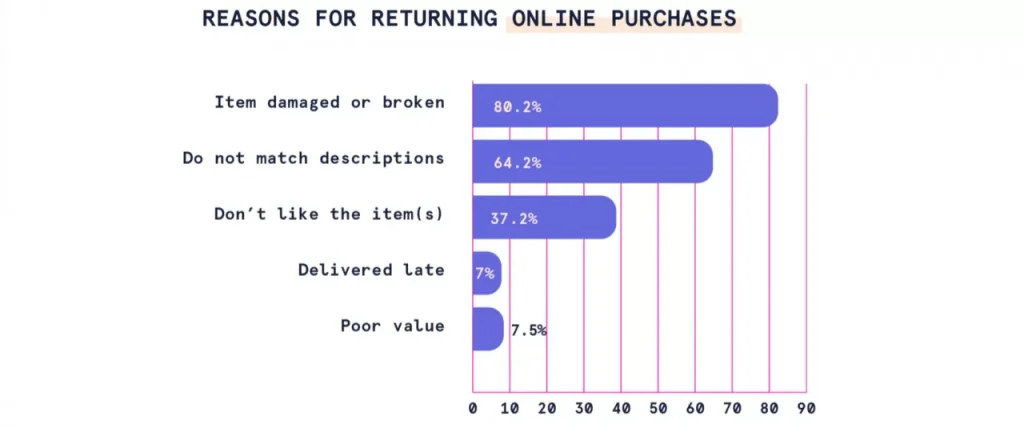One of the biggest challenges ecommerce businesses worldwide face is lowering product return rates. Not only do returns incur inconvenient hidden costs, but it often takes retailers sometime before noticing that they’re losing a significant amount of profit due to product returns.
While returns can’t be avoided completely, awareness and action are key. Check out some of the main factors an ecommerce company has to consider when dealing with product returns, what causes a customer to send something back and best practices to turn potential returns into revenue opportunities.
There are several reasons why a customer chooses to send a product back after they’ve received it. Sometimes a product is returned simply because a customer is no longer interested in keeping it. Other times, a customer will order multiple items on a whim—then, upon receiving the order, decide to return the pieces they don’t care to keep.
Then there are the consumers (19 % of them, to be exact) who will deliberately order multiple variations of a single item (such as different colours or sizes), to then choose the item that suits them best and return the rest. Details on how to calculate the rate of return (RoR).
These are just a few of the many reasons why a consumer would consider returning a product, but the impact on a retailer is largely the same: additional costs to ship and re-stock as well as profit loss. While returns can’t be avoided completely, awareness and action are key.
Top Factors Influencing Product Return Rate
Let’s face it: Customer satisfaction is something you can’t always control.
There is no way to prevent an online shopper from ordering multiple variants of basically the same product and then deciding to return one (or more, depending on how many they ordered). This is something no ecommerce business can control because it’s in the realm of consumer behaviour.
The graph below shows the top reasons why customers return products. The quality of the product received is the main factor behind product returns: over 80% of returns happen because the product is simply damaged or broken, and the customer is forced to send it back.

The Dreaded Costs Behind a Product Returns Process
The return process has obvious negative impacts on retailers in terms of cost, including:
- The cost of labour: This also includes warehousing, shipping and restocking.
- The cost of damaged goods: If a product is so damaged that it cannot be resold, the company needs to scrap it, which is an additional expense.
- The cost of faulty products: When a product is not destroyed, but has a glitch or a bump, customers naturally ask for a refund or a product replacement.
- The cost of reselling the product: A returned product may need to be repackaged, redone or refurbished, but also remarketed.
Most Frequently Returned Ecommerce Products
In the US alone, 21% of product returns were clothing items, followed by:
- Shoes (12%)
- Consumer electronics (8%)
- Bags and accessories (6%)
- Books, music, movies and games (5%)
- Cosmetics and body care (5%)
When compared to clothing, many consumers tend to take their health and entertainment platforms much more seriously (the latter might sound paradoxical, but it is true). Items of clothing, fashion accessories and electrical appliances are taken for granted much more than a medical device or a video game console, especially if it’s bought for the younger demographic.
This is why people who take good care of their health, as well as people from the gaming community, simply spend much more time choosing the right product for them. They rarely make rushed decisions, and carefully decide whether or not to purchase something.
In other words, the risk is much lower when purchasing clothes than a health product. Even if you have to return clothes, it won’t be a big problem, because a longer waiting period isn’t perceived as a major problem. The higher the necessity for a product, the lower the chances for its return upon delivery.
Best Practices to Combat Ecommerce Returns
Although it is not possible to eliminate product return as part of ecommerce, businesses can be more prepared by following the trends and analysing statistics fresh from the market. But before we delve deeper into ecommerce return rate statistics, here’s a tip for reducing your product return and improving customer experience.
1. Display a transparent product return policy
Chances are higher that a product gets returned if a customer isn’t sure what kind of product they are purchasing; also, a customer should be fully informed about your terms of service.
This means that the retailer retains the right not to resend or refund a product (for example, if the product has been visibly tampered with, disassembled, etc.). This is why it’s good to have a written return policy and to let the customers know in which cases you are prepared to resend or refund a product.
A well-written return policy will help you increase online sales and lower that return rate.
2. Include accurate product descriptions
The more informed your shoppers are on exactly what they’re buying, the less likely they are to make a purchase that they will regret and then return. Make sure you give as much information as possible in the product description, as well having clear and detailed product photos. But also consider going one step further and enabling customer-generated reviews, this will allow shoppers to discuss issues that may normally drive returns, as well as give you insight into the type of information they want to know about your products.
By writing out your product descriptions so that they contain complete information on the product, you will enable customers to know exactly what they are about to order. Remember, there are no lesser details here; the product description should contain product dimensions, colour, a list of removable parts (if any), including other technical specifications.
If possible, a user manual should also be included, so there are no grey areas as to what the product is and how exactly it is used.
The Beauty industry does a great job at informing their customers. Because of the sensitive and personal nature of their products, consumers are interested in knowing the ingredients that go into the products they purchase and any potential health risks associated with them.
3. Use high-quality product images and video
Ecommerce is, above all, a means of visual storytelling. While we’re taught as children to “never judge a book by its cover”, the reality is that many consumers do when it comes to shopping online. Add to that the fact that a customer often isn’t physically seeing the product before purchasing and it becomes that much more important to wow them with visuals that show the quality of your brand.
When a consumer has found a product that interests them, there is an expectation for multiple high-resolution product images. These images should be shot from different angles and include close-ups so that every aspect of the product is visible.
Including more than three to five images on a product page is an effective tactic to drive more add-to-carts and increased conversions, but also to reduce returns.
If you want to master this strategy, go one step further by including product videos. Granted, there are also other options such as 360-degree photos and early adoptions of AR/VR, but before these technologies were widely adopted and accepted by consumers, user-generated photography (especially from Instagram) combines compelling photography and social validation by showcasing products in real-life situations.
4. Sell them the right products in the first place
Personalisation has been the hot topic in ecommerce for the last 3 years, and yet proper appreciation of it remains elusive to many. In a recent survey we conducted, over half of business owners interviewed, thought it meant including someone’s name on the product.
Ouch! Indeed search engines, having had a history of exactly that type of search on the word “personalisation” remain intransigent in moving to its actual meaning now. Personalisation is offering the right products for each consumer. Customer-centric. Their colours, tastes, preferences, and by “right” we mean the ones that machinates with their existing purchases.
Taking personalisation further is the future of ecommerce marketing, which leads to hyper-personalisation. This is when an AI algorithm uses all the UTM data captured from your site, is used to best calculate what each consumer is most likely to buy next, and importantly keep.
When a consumer has found a product that interests them, it remains often a whim or pretty image you have created to secure an order. This remains the focus of many retailers, without appreciating they are making a rod for their own back, simply seeing the return come back a week later.
Consider then the benefit of instead of being attracted by the image, to something matching their actual buying criteria, on many other levels. Wardrobe synergy, lifestyle appreciation, colour and material preferences, in fashion.
Or for food and wine, fitting to the taste and desires of that individual consumer’s liking. Having arrived here, let us take this another stage further, and rather than wait for the consumer to come to your site, you take that individual’s product offering to them.
Make use of an additional email facility that bolts onto any existing ones, and proactively encourages your consumers to buy exactly the perfect products that meet their designs, while minimising the rate of returns. With no segmenting involved whatsoever, these are the lowest rate of return sales available.





